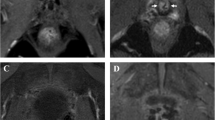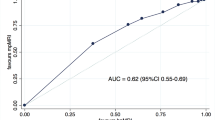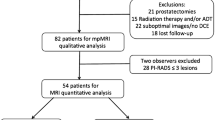Abstract
Purpose
To determine whether focal peripheral zone enhancement on routine venous-phase CT is predictive of higher-grade (Gleason 4 + 3 and higher) prostate cancer.
Materials and methods
IRB approval was obtained and informed consent waived for this HIPAA-compliant retrospective study. Forty-three patients with higher-grade prostate cancer (≥Gleason 4 + 3) and 96 with histology-confirmed lower-grade (≤Gleason 3 + 4 [n = 47]) or absent (n = 49) prostate cancer imaged with venous-phase CT comprised the study population. CT images were reviewed by ten blinded radiologists (5 attendings, 5 residents) who scored peripheral zone enhancement on a scale of 1 (benign) to 5 (malignant). Mass-like peripheral zone enhancement was considered malignant. Likelihood ratios (LR) and specificities were calculated. Multivariate conditional logistic regression analyses were conducted.
Results
Scores of “5” were strongly predictive of higher-grade prostate cancer (pooled LR+ 9.6 [95% CI 5.8–15.8]) with rare false positives (pooled specificity: 0.98 [942/960, 95% CI 0.98–0.99]; all 10 readers had specificity ≥95%). Attending scores of “5” were more predictive than resident scores of “5” (LR+: 14.7 [95% CI 5.8–37.2] vs. 7.6 [95% CI 4.2–13.7]) with similar specificity (0.99 [475/480, 95% CI 0.98–1.00] vs. 0.97 [467/480, 95% CI 0.96–0.99]). Significant predictors of an assigned score of “5” included presence of a peripheral zone mass (p < 0.0001), larger size (p < 0.0001), and less reader experience (p = 0.0008). Significant predictors of higher-grade prostate cancer included presence of a peripheral zone mass (p = 0.0002) and larger size (p < 0.0001).
Conclusion
Focal mass-like peripheral zone enhancement on routine venous-phase CT is specific and predictive of higher-grade (Gleason 4 + 3 and higher) prostate cancer.










Similar content being viewed by others
References
Engeler CE, Wasserman NF, Zhang G (1992) Preoperative assessment of prostatic carcinoma by computerized tomography. Weaknesses and new perspectives. Urology 40:346–350
Chang P, Friedland GW (1990) The role of imaging in screening for prostate cancer. A decision analysis perspective. Invest Radiol 25:591–595
Purohit RS, Shinohara K, Meng MV, et al. (2003) Imaging clinically localized prostate cancer. Urol Clin North Am 30:279–293
Hricak H, Choyke PL, Eberhardt SC, et al. (2007) Imaging prostate cancer: a multidisciplinary perspective. Radiology 243:28–53
O’Dowd GJ, Veltri RW, Orozco R, et al. (1997) Update on the appropriate staging evaluation for newly diagnosed prostate cancer. J Urol 158:687–698
Platt JF, Bree RL, Schwab RE (1987) The accuracy of CT in the staging of carcinoma of the prostate. AJR Am J Roentgenol 149:315–318
Barentsz JO, Richenberg J, Clements R, et al. (2012) ESUR prostate MR guidelines 2012. Eur Radiol 22:746–757
Turkbey B, Pinto PA, Mani H, et al. (2010) Prostate cancer: value of multiparametric MR imaging at 3 T for detection—histopathologic correlation. Radiology 255:89–99
Hoeks CM, Barentsz JO, Hambrock T, et al. (2011) Prostate cancer: multiparametric MR imaging for detection, localization, and staging. Radiology 261:46–66
Rosenkrantz AB, Sabach A, Babb JS, et al. (2013) Prostate cancer: comparison of dynamic contrast-enhanced MRI techniques for localization of peripheral zone tumor. AJR Am J Roentgenol 201:W471–W478
Hoeks CM, Hambrock T, Yakar D, et al. (2013) Transition zone prostate cancer: detection and localization with 3-T multiparametric imaging. Radiology 266:207–217
Mikuz G (2007) Clinical pathology of urological tumours, 1st edn. Boca Raton: CRC Press
Stark JR, Perner S, Stampfer MJ, et al. (2009) Gleason score and lethal prostate cancer: does 3 + 4 = 4 + 3? J Clin Oncol 27:3459–3464
Acknowledgments
Statistical support was provided with help from NIH Grant 2UL1TR000433-06.
Author information
Authors and Affiliations
Corresponding author
Rights and permissions
About this article
Cite this article
Glazer, D.I., Davenport, M.S., Khalatbari, S. et al. Mass-like peripheral zone enhancement on CT is predictive of higher-grade (Gleason 4 + 3 and higher) prostate cancer. Abdom Imaging 40, 560–570 (2015). https://doi.org/10.1007/s00261-014-0233-7
Published:
Issue Date:
DOI: https://doi.org/10.1007/s00261-014-0233-7




